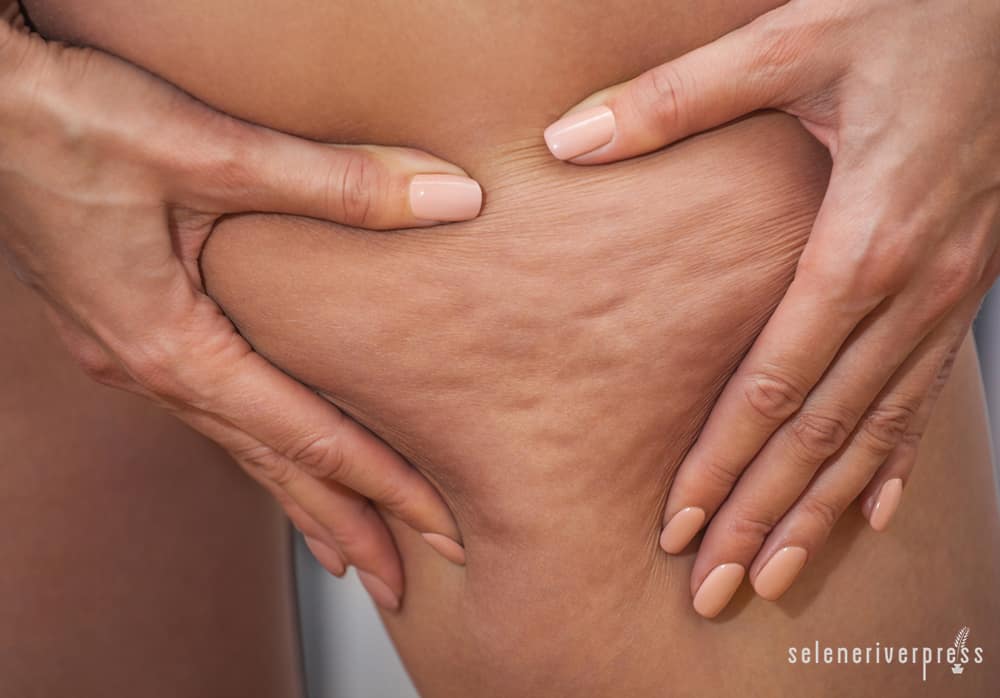With the passing of Memorial Day comes the swift arrival of swimsuit season (or, for us non-swimmers, short- and tank top-season). Some of us are excited by the promise of showing more skin as the days of summer approach. But others of us feel nothing but unease and dread about what’s hidden under our sleeves and pant legs: cellulite.
However, shedding our sweaters and corduroys doesn’t have to lead to dread. If you have any questions about cellulite, perhaps some answers will ease your mind. Self-health education to the rescue!
First things first, what is cellulite? Cellulite a common condition defined by deposits of normal subcutaneous fat—the kind that lies just beneath the skin—within fibrous connective tissue, called fibrous septae. As the name indicates, the job of this connective layer is to connect skin to the underlying tissue. But in cases of cellulite, the excessive subcutaneous fat pushes its way in between and above the connective tissue, while the connective tissue holds on to the skin as tight as it can. This results in the bumpy, puckered look of cellulite.
The good news is that cellulite isn’t dangerous or life threatening. It’s more of an annoyance than anything else. As most of us know, it most commonly presents itself as dimpled thighs and puckered buttocks, leading to unfortunate comparisons to cottage cheese. I myself have visions of cellulite looking like cottage cheese underneath the skin’s surface—no matter how inaccurate that might be.
Now let’s talk about one of the biggest cellulite myths: only overweight and out-of-shape people get it. This is simply not the case. According to ABC News, even the most slender people out there can end up dealing with cellulite.
It is true, however, that far more women (90 percent) will have cellulite at some point in their lives than men (only 10 percent). One of the reasons for this discrepancy is that fibrous septae connects to the skin in a different way for women and men. In women, it has a perpendicular structure, but in men it’s more of a 45° angle. Geometrically, men’s bodies are better equipped at keeping that subcutaneous fat contained.
So what causes cellulite? The answer is a mystery to the scientific community. However, if you asked this self-healther, the key player seems to be the strength of the connective tissue. And what’s connective tissue made of? Collagen.
Chiropractors know how important collagen is for strong connective tissue. And if they’re trained in nutrition, they probably use Standard Process supplements and collagen-builders like bone broth, raw amino acids, and plenty of vitamin C complex. Lacking these foundational nutrients from an early age, even in utero, can explain why young people are afflicted—they’re already falling apart at the seams! While we can’t go back and rebuild our foundations, we can at least minimize the damage by getting these nutrients into our bodies now.
Meanwhile, the scientific community trots out all the usual suspects: hormone imbalance, genetic predisposition, and lifestyle choices. While you don’t really have much control over genetics, you can work with your health care provider to keep your hormone levels in-check. You can also make sure your lifestyle choices include a nutrient dense, whole food diet and plenty of healthy activities throughout the day. But that’s just general common sense.
As always, Maria Atwood offers help. In her post “Help! My Body Is Getting Flabby,” Maria tells the story of how she got a panicked, early morning phone call from a friend who had just realized her body wasn’t as firm as it had once been, and she wanted to know why and what to do about it. At 6 a.m. In the morning. Lucky for us, Maria shared her answers with the rest of us on SRP.
In addition to making healthy food and activity choices, I’ve heard of a couple other suggestions. Dry skin brushing may help with the flow of your lymphatic system, ridding your body of toxins and improving circulation. These are both good things when it comes to dealing with cellulite. Also, deep tissue massage has been shown to help reduce the appearance of cellulite for several days after. If you need another excuse to schedule that massage appointment, here it is. :)
The next time you wince at your swimsuit-clad reflection in the mirror, know that you aren’t alone. Don’t hide your beautiful body underneath extra layers. Just remember everything you’ve just learned about cellulite. And, if you’re so inclined, strike up a conversation about it with the person on the chaise lounge next to you. Chances are they’ll be grateful to be your poolside pal for the day.
Images from iStock/dimid_86 (main image), ferrerivideo (post image).



